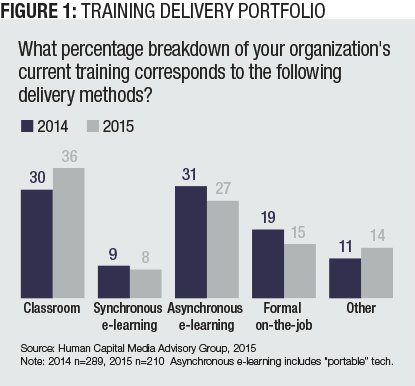Data show classroom-based instruction has been used in more enterprises, for more content areas and to cover far more learners. Yet, e-learning has its advocates who say instructor-led or self-paced courses are a more effective option.
Chief Learning Officer magazine Business Intelligence Board research has shown a steady increase in the use of self-paced and instructor-led e-learning in the choices most chief learning officers make today. In 2014, CLOs reported for the first time that self-paced and instructor-led e-learning courses were used more often than classroom-based instruction.
More than 210 respondents shared their thoughts on the appropriate mix of learning delivery for CLO’s 2015 Learning Delivery survey, and this year’s research shows classroom training is again used more often than e-learning overall — though not by much.
The Current, Shifting Mix
Last year, CLOs reported using more synchronous and asynchronous e-learning than classroom-based training. This is consistent with several years of slow gains and small retreats for both forms of e-learning. This year’s slight increase in classroom training likely doesn’t represent a trend reversal — classroom learning has been declining since 2010 — but simply a small shift (Figure 1).

Modalities such as performance support or peer-based training represent other valuable learning experiences.The survey found that mobile devices were used for a small amount for training — about as often as video-based instruction. Further, a significant number of organizations are leveraging formal on-the-job training, though its use hasn’t changed much in the past couple of years.
CLOs adjust their learning delivery methods based on effectiveness, convenience and cost. Interestingly, when organizations increased classroom-based instruction, CLOs said effectiveness was the reason. On the other hand, organizations that reduced their classroom-based instructor-led training were most often driven by cost.
In the future, CLOs generally expect classroom-based ILT to represent a declining portion of the delivery portfolio primarily because of cost. Both synchronous and asynchronous e-learning will continue to gain portfolio share in most enterprises because of continued pressure on development budgets and greater flexibility in scheduling and delivery. Simulations are increasingly getting the attention of CLOs as an effective method of instruction. CLOs expect to use more simulations in 2016.
CLOs are also expressing a resurgent interest in video-based instruction. The increased potential is primarily a result of the near ubiquitous availability of video-on-demand devices and sufficient bandwidth to ensure a quality learner experience.
CLOs are also expanding their interest in mobile training delivery, with the average amount of training delivered to mobile devices in 2015 increasing significantly over 2014. Enterprises that use mobile delivery report an average of 26 percent of their e-learning training is delivered to a mobile device, slightly less than the 28 percent predicted last year.
And while CLOs continue to prefer one modality to another for particular content, they often believe their choice represents the most appropriate method for the content and the learner.
One way the message can be defined is broadly by content type: business skills courses or IT content. Broadly, preferences for delivery modality by content have changed little since 2007. More CLOs describe classroom-based ILT as the primary delivery modality for business skills training (32 percent) than as primary for IT skills training (28 percent) — but the magnitude of the preference for classroom-based is declining overall.
For new-hire training, the preference for classroom-based also remains strong but declining — 39 percent of CLOs say it is the primary modality of new-hire training, down from 47 percent in 2014. Compliance training is the only learning content domain where classroom-based is not considered the primary method. Most enterprises prefer self-paced e-learning (58 percent) to classroom-based instructor-led training (12 percent).
Despite the recent and continued emphasis on social media to support learning, the most significant types of informal learning aren’t technology based. On-the-job experiences, mentoring, discussions and networking with other professionals are traditional, low-tech forms of instruction and considered among the most important forms of informal learning.
CLOs see the value of classroom instruction when it is an appropriate method for the content to be conveyed, such as business skills. E-learning, however, is consistently seen as an increasingly appropriate methodto deliver IT skills content, with about 31 percent of the enterprises selecting at least one form of e-learning as the primary delivery method.
In fact, the percentage of CLOs who indicate e-learning is the primary modality for business skills is increasing. In 2010, only 15 percent considered e-learning a primary delivery modality for business skills courses.
Current instructional practices for IT skills tend to emphasize both independent study and practice over shared learning and group work. At the same time, both research and practice suggest that teaching technology using technology yield better results more often than teaching nontechnology content using technology.
As collaborative technologies make their way into online instructional modalities, we will likely observe increased value and use of collaborative e-learning experiences when teaching both IT and business skills, reflecting the trend in work itself.
Change Is Coming
CLOs remain mindful that learning delivery choice is an effort to ensure relevance to the target learners. One CLO surveyed said, “Learning is becoming more self-directed for higher level and more senior leaders. … More junior staff still require direction and set objectives and goals.”
Even so, there were four shifts in delivery that CLOs anticipate: more mobile, more e-learning, more simulations and more video. 
As we reported last year, mobile learning is not strongly reflected in the current paradigm. Nonetheless, mobile appears as a beacon of opportunityto many CLOs, both as a portal to insight and as a preferred delivery approach.
However, another referenced a common theme: “We are not ready for mobile activity or the promotion of self-paced learning in our current work environment.”
E-learning will continue to gain importance. This shift supports the need to “provide a larger number of focused self-paced courses that are easily consumed by our customers and support engineers on mobile devices” and to support “training that can be consumed quickly and easily” and “greater ability to access [just-in-time] learning for specific needs,” wrote one CLO.
CLOs are generally complementary of self-paced vendor content; they believe it raises production value for all instruction. Simulations and games-based instruction is also expected to increase. One CLO said their company will use “more chunked simulations and games, allowing us to present content in an entertaining way while [learners] choose to replay to get the best possible result.”
While overall use remains low, acceptance of video in corporate education has greatly increased in the past year as part of the self-paced curriculum. Several CLOs expect that trend to continue. Other CLOs are moving even further combining “shorter, video-based [instruction] on mobile platforms.”
Some CLOs anticipate a broader responsibility shift from content creation and delivery to identifying appropriate informational and instructional material, making it conveniently available to the relevant populations. One CLO said, “I think learning professionals should get out of the business of being content subject-matter experts and move more into being content-curating experts so that learners consult with learning professionals … to discover the appropriate content at the critical moment.”
While the CLOs focus will remain on delivering the right content to the right learners using the right tools efficiently and cost effectively, trends suggest e-learning, mobile and video learning will be a growing part of the mix.














